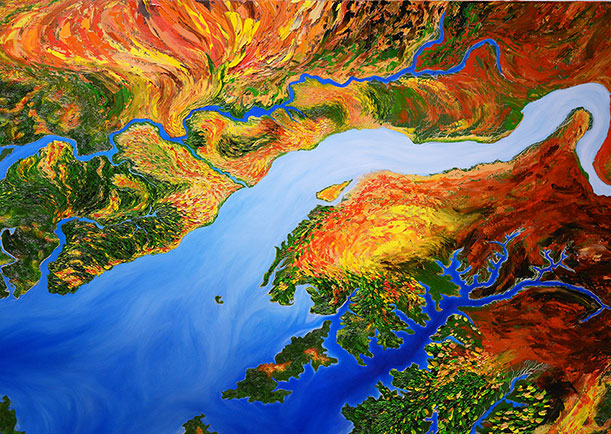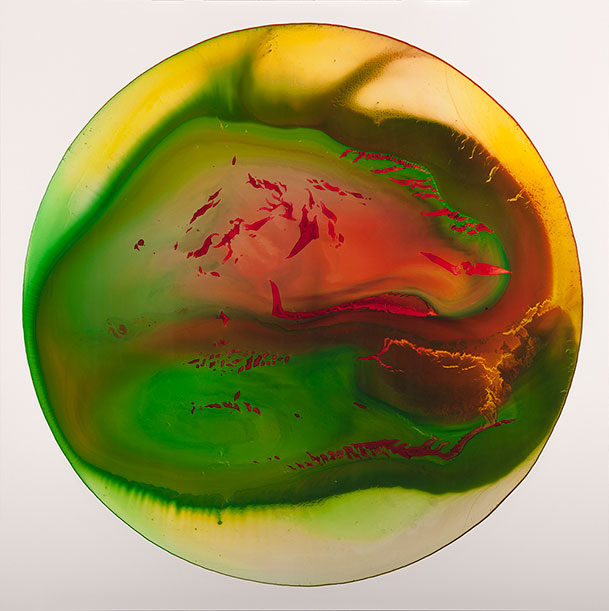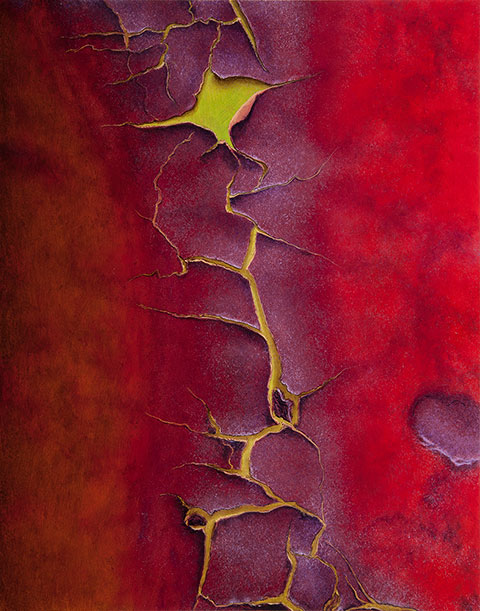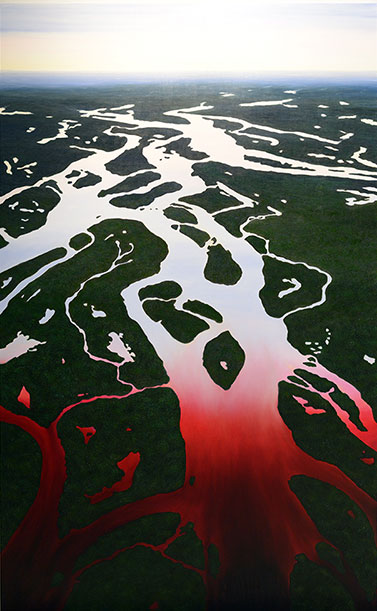Toxic Runoff Yellow and Other Paint Colors Sourced From Polluted Streams
An engineer and an artist at Ohio University team up to create paints made of sludge extracted from streams near abandoned coal mines
Artist John Sabraw uses paint made from the toxic runoff in streams located near abandoned coal mines in his abstract paintings. Chroma S1 1, by John Sabraw. Image courtesy of the artist.
When Guy Riefler pursued a bachelor’s degree in environmental engineering at Cornell University in 1991, it was with the intention that he would spend his career cleaning up pollution. So, after earning advanced degrees and completing his post-doctoral work at University of Connecticut, he landed a position as a professor at Ohio University, and made acid mine drainage (pdf)—the environmental bane of the area in and around Athens, Ohio—a major focus of his research.
In the state of Ohio, Riefler explains, there are hundreds of square miles of underground coal mines, all abandoned sometime before the Surface Mining Control and Reclamation Act of 1977 was passed. Operators of the mines simply picked up and left, since, prior to the act, they had no legal obligation to restore the land to its previous condition. They turned off pumps and, as a result, the water table rose and flooded the underground passageways. The water became acidic, as the oxygen in it reacted with sulfide minerals in the rock, and picked up high concentrations of iron and aluminum.
“When this water hits streams, it lowers the pH and kills fish,” says Riefler. “The iron precipitates form an orange slimy sludge that coats the sediments and destroys habitat.”

“You can get anything from a mustardy yellow all the way to an incredibly rich, deep, deep almost-black brown out of it,” says Sabraw, of the pigments. Bijagos, by John Sabraw. Image courtesy of the artist.
To tackle this problem, Riefler, an associate professor of environmental engineering, and his students started to flesh out an idea: they would take this slimy, metal-laden runoff from coal mines and turn it into paint. Beginning in 2007, some undergraduate students explored the possibility. Then, in 2011, Riefler received funding to look into the process in greater detail and devote a group of graduate students to the effort.
Toxic runoff from coal mines and commercial red and yellow paints, you see, have a common ingredient—ferric oxyhydroxides. Once the acidic ground water hits the air, the metals in it oxidize and the once-clear water turns yellow, orange, red or brown. To make paints of these colors, international companies basically mimic this reaction, adding chemicals to water tanks containing scrap metals.
After more than half a decade of dabbling in making pigments, Riefler and his team have a practiced method for producing paints. They start by collecting water directly from the seep in the ground; the water sample is still fairly clear because it just barely has made contact with the air. The scientists then take the sample to their laboratory, where they raise its pH using sodium hydroxide and expose it to oxygen at a certain rate, bubbling air through the water to oxidize the iron. While this is going on, the metal components, invisible up until this point, blossom into rich colors.
The particles within the water settle, and the researchers collect the iron sludge. Riefler dries the sludge and then mills it into a fine powder. The powder can then be added to alkali refined linseed oil, a traditional binder, to create an oil paint.
Riefler acknowledges one rather critical shortfall. ”I understood the chemistry and the process engineering, but didn’t have a clue how to tell a good pigment from a bad pigment,” he says.
Luckily, Riefler didn’t have to look far to find an eager partner in the art world. John Sabraw, an associate professor of art at Ohio University, uses sustainable materials in his own artwork and encourages his students to think about how they too can be sustainable in their practice. In fact, one of his courses, which students have dubbed “The Save the World Class,” brings together undergraduate students from a variety of disciplines—business, political science and art majors, for example—and asks that they collaborate to design and execute a sustainable solution to an environmental issue in their local community.
Sabraw has also studied the history of pigments and taught classes on making paints from scratch. He was already familiar with acid mine drainage when Riefler approached him. On a visit to some effected streams nearby with a group from the university, he had actually been tempted to collect some of the colored sludge.
“They tapped me to see if I could be a tester for the pigments, to test whether they would be a viable paint product,” says Sabraw.
For a little over a year now, Sabraw has been using acrylic and oil paints made from the dried pigments in his paintings. He has been impressed with the range of colors that can be made with the iron oxides. “You can get anything from a mustardy yellow all the way to an incredibly rich, deep, deep almost-black brown out of it,” he says. Like any brand of paint, this one has a consistency and other qualities that any artist has to adjust to, but Sabraw says its comparable to other paints on the market, and he enjoys working with it.
Riefler’s plan is to continue tweaking different variables in the process—things like temperature and pH—to perfect his paint product over the next year. In this research and development phase, he is being mindful to create something that is economically viable and that meets industry standards. Sabraw reports that the paints are safe to both produce and use.
He will be sending the product to pigment vendors. Ultimately, the plan is to sell the paint commercially, with the proceeds going to cleaning up polluted streams in Ohio.
“Our latest estimate is that one highly productive AMD seep near us would produce over 1 ton of dry pigment per day that could generate sales of $1,100 per day,” says Riefler. Costs are still being calculated, so it is unclear at this point whether or not the venture will turn a profit. “Even if we just break even, that would be a success, because we would be cleaning up a devastated stream for free and creating a few local jobs,” he adds.
The project is certainly a clever model for stream remediation, and both Riefler and Sabraw are driven to bring their product to the market, so that they can have a positive impact on the environment. Here, something that is nasty—acid mine drainage—is turned into something useful—paint—and beautiful—Sabraw’s paintings, with organic shapes reminiscent of trees, streams and landforms.
“What we are doing is trying to make the streams viable. We want life back in the streams,” says Sabraw. “It is certainly possible, and what we are doing is enabling that to happen.”
John Sabraw’s exhibition “Emanate” is on display at Kathryn Markel Fine Arts in Bridehampton, New York, from July 27 to August 10, 2013. He also has a show, “Luminous,” which opens at the Richard M. Ross Art Museum at Ohio Wesleyan University on August 22 and runs through October 6, 2013. Both exhibitions feature works made with the paints.
/https://tf-cmsv2-smithsonianmag-media.s3.amazonaws.com/accounts/headshot/megan.png)






/https://tf-cmsv2-smithsonianmag-media.s3.amazonaws.com/accounts/headshot/megan.png)